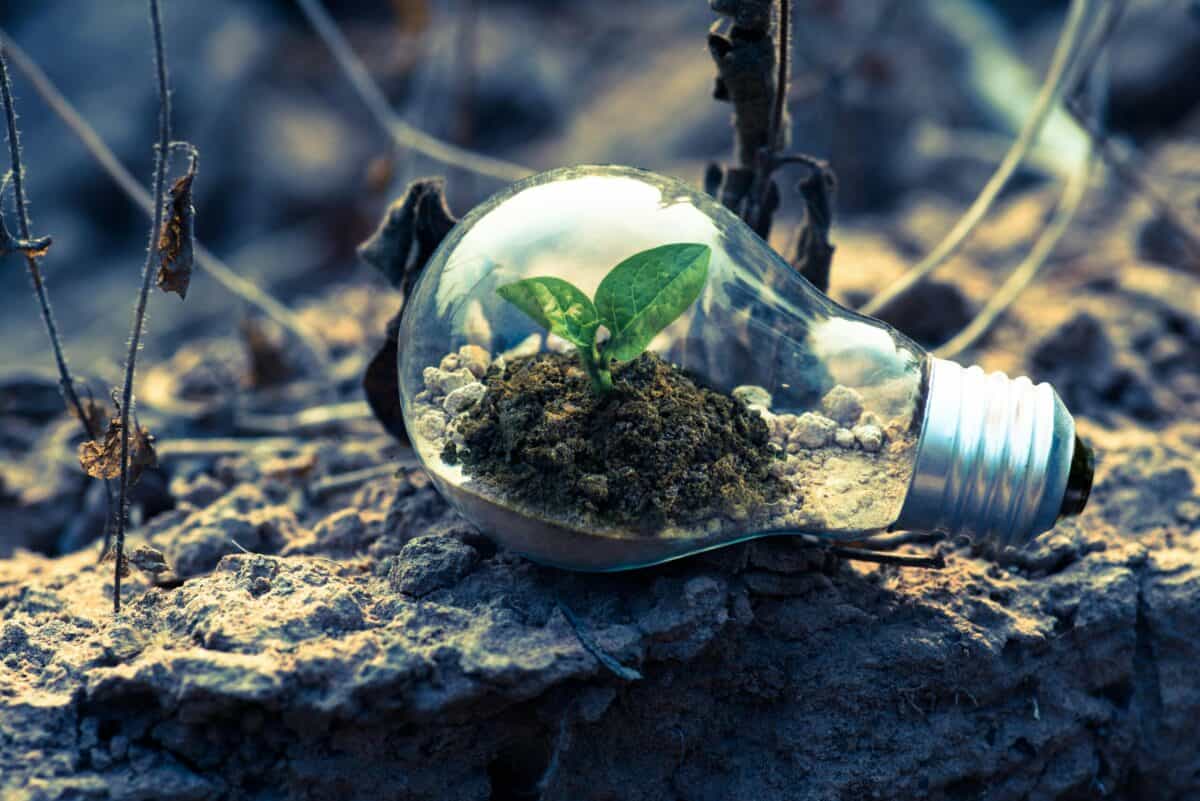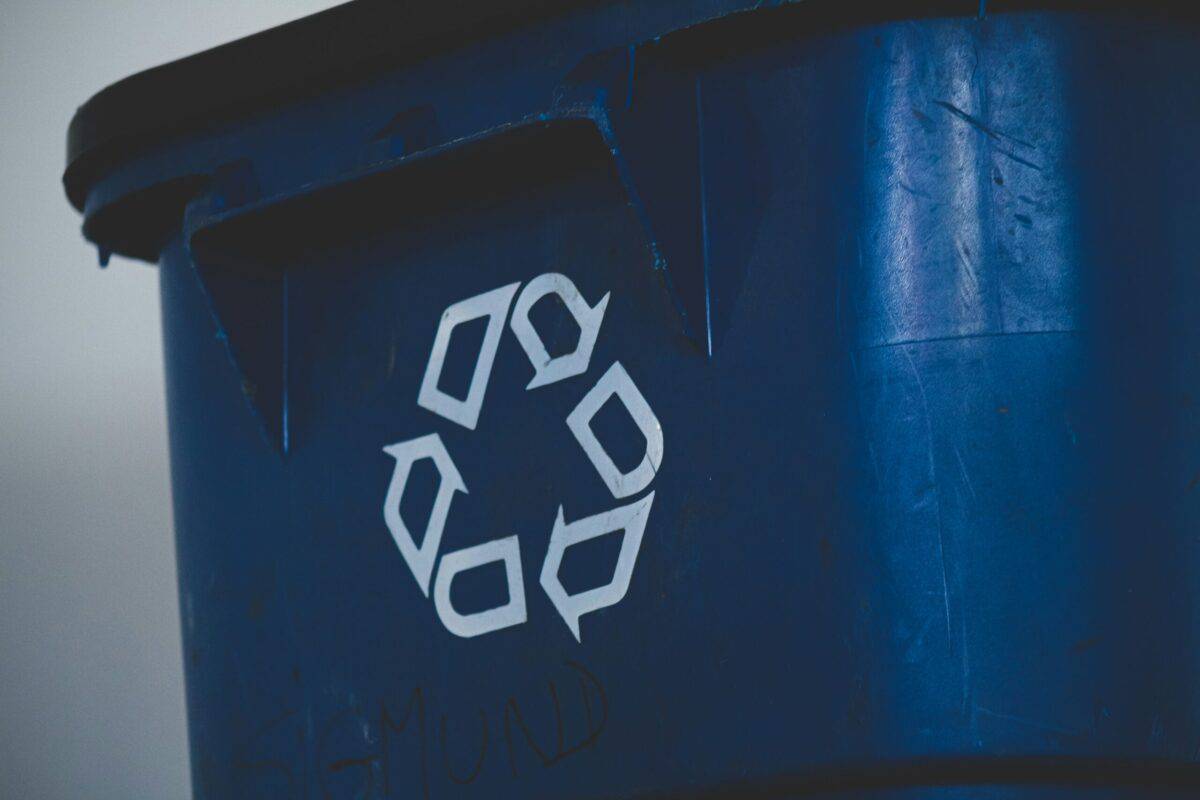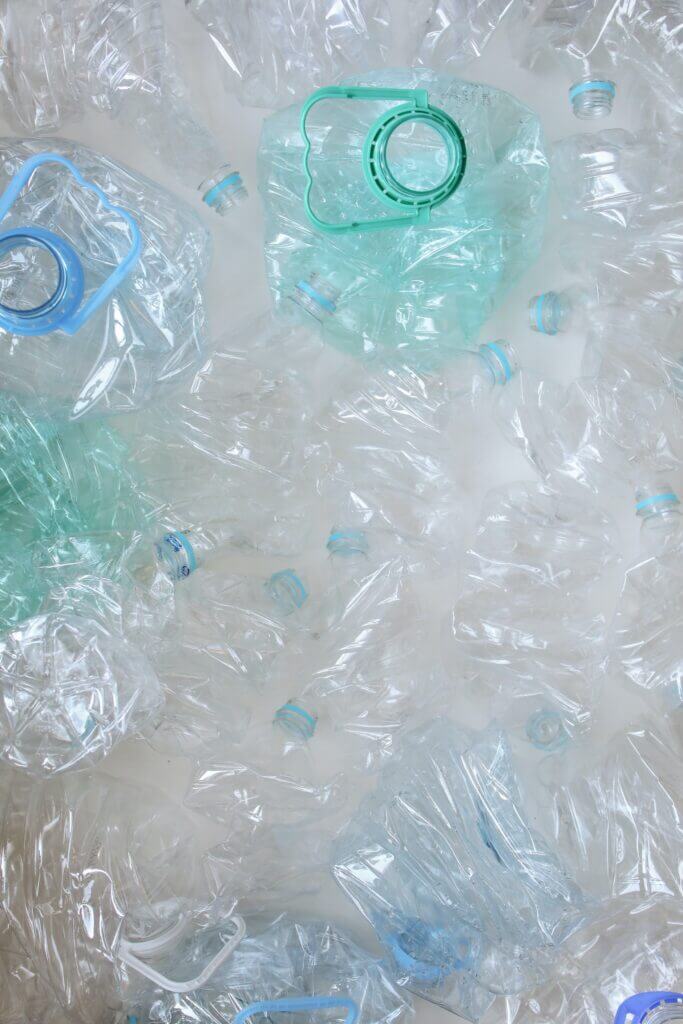Last updated on May 2nd, 2024 at 03:04 pm

My Top 5 Sustainability Insights from Year One
It’s been one year since I started my deep dive into all things sustainable. Here is a summary of the most important lessons I’ve learned.
In early 2023, as I was researching a variety of ways to be more green in my own life, I found myself getting increasingly entangled into the complicated web of sustainability. I mean, I’ve always cared about being green, but each new thing I discovered only made me crave more knowledge. Sifting through mountains of information was fascinating yet laborious, and I realized that the average person couldn’t or wouldn’t take the time to engage on this level. I decided to make it my mission to educate others on sustainability.
Since then, I’ve read countless articles, studies, and blog posts; I’ve listened to podcasts, watched YouTube videos and documentaries, toured a handful of local facilities, joined a local Green Drinks group, and had multiple interesting conversations with a variety of people. I’ve learned so much, which helps me live better, but I also want to share what I know and make it more easily accessible and less confusing for everyone.
So without further ado, here are my top sustainability insights from Year One of my intensive exploration in this field.

1. Plastic is the devil
By now I think most people realize that plastic is troublesome. But I’m here to say that plastic sucks far worse than I had previously thought and much more that many fully comprehend. Here’s why.
Plastic is fossil fuel-based. Before plastic is even manufactured it carries a significant carbon imprint, starting with the extraction of non-renewable resources. If you thought big oil was on its way to being phased out by clean energy and electric cars, think again. That giant is not going away so easily as they move towards their ‘Plan B’, ramping up plastic manufacturing in order to continue lining CEO pockets at the expense of the planet. Currently, plastic production is on pace to double by 2050, and already creates four times more emissions than the airline industry, making it a fast-growing player in climate change. Per the NRDC, “Reducing plastic production is critical to combatting climate change.”
Plastic is laden with harmful chemicals. During the manufacturing process of plastic, a myriad of additives such as plasticizers, antioxidants, pigments, and flame-retardants are included, which pose a hazard to both the environment and animal/human health. Just ask those living in “Cancer Alley,” a stretch of land in Louisana bearing over 150 petrochemical facilities and refineries. This area is a prime example of environmental and social justice issues which disproportionately impacts BIPOC, rural, and low-income communities. Cancer rates in Cancer Alley are 95% higher than the rest of the United States. Besides cancer, these chemicals have been shown to lead to endocrine (hormone) disruption, organ dysfunction, negative pregnancy outcomes, and increased inflammation.
Plastic is not biodegradable. As you probably know, plastics can take hundreds of years to break down. During this process, they can leach the aforementioned toxic chemicals into the soil and groundwater. Existing environmental pollutants can bind with these chemicals, forming more harmful compounds that can take even longer to break down. PFAS, also known as ‘forever chemicals’, are an example of this.
One word: Microplastics. Eventually plastic breaks down into tiny pieces less than 5mm in size, which we then refer to as microplastics. These particles have been found in every ecosystem of the planet, from Mount Everest, and the clouds overhead, to the Mariana Trench deep in the ocean. They comprise 92% of the ever-growing Great Pacific Garbage patch, which is now twice the size of Texas.
In the ocean, these microplastics are frequently ingested by wildlife, piercing or blocking their digestive tracts, often leading to their demise. Plastic has been found in more than 60% of all seabirds and in 100% of sea turtles species. By 2050, it is estimated that the amount of plastic in the ocean will outweigh the sea life. In addition, recent studies have shown microplastics in our bloodstream, human placentas, and even breaching the blood-brain barrier. It is also estimated that we ingest 5 grams of plastic every week. That’s about the equivalent of a credit card. Yum.
Plastic is expensive and difficult to recycle. Only about 30% of all plastic ever made is currently being used, and its production continues to grow, while less than 10% of plastic is recycled. The rest piles up in landfills or waterways, taking hundreds of years to decompose. Even when plastics are recycled, this process can create additional environmental pollution. Multiple studies have detected significant amounts of microplastics in the wastewater and sludge flowing from plastic recycling facilities.
Plastic is hidden everywhere. It is not just the plastic water bottles, straws, bags, and other single-use plastic packaging you need to watch out for. Plastic shows up where you least expect it: in shampoos, cosmetics, toothpaste, and deodorant. It’s in chewing gum and cigarettes and wet wipes. It makes up nearly 70% of all clothing, most in the form of polyester. These sources all contribute to microplastic pollution, too.
Solution
Some plastic alternatives are simple to adopt, others not so much. I don’t think one can feasibly eliminate plastic altogether from daily life, but we can substantially decrease its use. Start simply by substituting single-use plastics. Bring your own grocery and produce bags to the store. Seek personal hygiene, cleaning, and food products enclosed in plastic-free packaging. Email your favorite brands and ask them to consider alternate packaging. Buy clothing made from natural materials. Find many more ways to decrease plastic in your life here.

2. Recycling is awesome, but…
As an avid recycler since childhood, I’ve been known to sift through the trash to retrieve recyclables that others have discarded. (It’s a bit of a sickness.) But as important as recycling is, it isn’t the best answer to saving the planet.
Recycling often seems like the first step toward sustainable living. It feels as though society is conditioned to prioritize recycling, then reducing and reusing, when in fact, the order should be reversed. Why?
The world of recycling is not a straightforward process, especially when it comes to plastic. It is an constantly evolving, complex industry. Many people don’t realize that recyclables are a commodity, just like other goods such as wheat, oil, or gold. The market fluctuates with supply and demand and other economic factors. These inconsistencies compound confusion regarding what items are recyclable.
Uncertainty whether an item is recyclable leads to “wishcycling,” where we add objects to the recycling bin and hope for the best. Incorrrectly placing non-recyclable or incorrect items into recycling bins is a very common problem that leads to high levels of contamination. This in turn can result in entire loads being landfilled rather than meticulously sorted and cleaned, which is costly and time intensive.
For example, throwing glass in with paper products, unless specifically directed to do so, compromises the quality of paper; some buyers will not purchase paper that has been mixed with glass. And paper materials such as newspaper or cardboard are rendered useless if they become wet, which will inevitably happen if a person decides to throw in a half empty gallon of milk or bottle of soda that that bursts and soaks everything it touches.
Sometimes the cost of collecting, processing, and transporting recyclable materials far exceeds their resale value. In addition, creating new products from recycled materials is very expensive, up to 600% more than the cost of using virgin plastic, according to a local company that I toured. Much of this inflated cost is absorbed by the consumer.
Not all types of plastic can be recycled either. For example, #7, the ‘other’ category of plastic, is composed of a combination of different types of plastic, so to separate them out would be impossible. Some recycled plastics are technically downcycled, being made to create items of lower-quality. Yet other plastics collected for “recycling” are sold to cement plants who burn them as a fuel source for their kilns, a very common practice. The cement industry is responsible for 7% of global greenhouse emissions. Burning plastics can release harmful toxins like dioxins into the air, but proponents deny this is an issue.
Some materials, particularly plastics, degrade in quality each time they are recycled. This degradation means that recycled materials can only be reused a limited number of times before they become unusable and ultimately end up in a landfill. In this situation, recycling simply prolongs the inevitable end of life destination. This is unlike materials like glass or metal, which can be recycled infinitely without any loss in quality.
Finally, all these complications culminate in pitiful recycling rates across the United States and the world. In the U.S., the 2021 plastic recycling rate was estimated to be a paltry 5-6%. Even easily recycled items suffer terrible recycling rates: only 35% of aluminum containers and 31% of glass bottles are recycled.
Solution
For these reasons, the principles of “reduce” and “reuse” deserve more emphasis as the most important and effective actions in minimizing environmental impact.
Reducing consumption reduces the demand for new materials. Before you buy a new product, evaluate whether you truly need it. Overconsumption is the norm in our society and we have become so conditioned to buy more that we often don’t even stop to think before doing so. This is the first and most important step of all to live sustainably.
Shop wisely, purchasing eco-friendly products made with renewable materials as much as possible, especially seeking out plastic-free alternatives. Support companies who utilize sustainable methods and employ fair labor practices. Learn how to discern what products are actually eco-friendly.
Extend the life of objects by proper maintenance. Repair them as able before throwing them out or repurpose for another use. Make sure to donate or give away unwanted items in good condition.
By decreasing consumption and mindfully reusing items, the need for recycling decreases.
Still, recycling is ultimately a very valuable pursuit as the process uses a fraction of the energy and resources required for manufacturing of goods from virgin materials. For example, recycling aluminum cans uses only 5% of the energy used to produce cans from virgin aluminum. And as mentioned, glass and metal can be recycled forever with no decrease in quality.
So despite recycling obstacles, keep on filling those curbside bins–with the right items. Take a moment to educate yourself on what materials are accepted by your local recycling company.
Check out my recycling tips here.

3. Beef production is more calamitous than many realize
As a lifelong meat lover, researching the beef industry was a very hard one to stomach, so to speak.
Most likely, you’ve heard about the greenhouse gas (GHG) emissions that result from cow flatulence. In case you need a refresher, here’s a quick summary: A cow’s digestion process produces methane, which is a potent GHG. When this gas is expelled from either end of the cow, it ultimately finds its way to the atmosphere, contributing to the heat trapping process that leads to climate change. These expulsions (especially the burps) contribute to half of the the agriculture industry’s overall emissions, which in turn account for 14.5% of the world’s total GHG emissions.
Besides being a huge source of GHG, the cattle industry is by far the leading cause of deforestation across the planet. In response to the world’s evergrowing insatiable appetite for beef, livestock producers clear forests to convert land to grazing pastures and for growing animal feed.
Deforestation, especially of tropical rainforests, is nothing new. Logging for wood and paper products, while impactful, is responsible for just 13% of deforestation. While the palm oil industry has garnered a lot of attention lately, it, paired with soybean cultivation, is responsible for 18%. While these industries are no doubt impactful, they don’t hold a candle to the impact of the cattle industry.
It may surprise you to know that clearing land by the cattle industry is responsible for 41% of worldwide deforestation. This includes a whopping 80% of the deforestation taking place in the Amazon rainforest, which has decreased in size by 17% over the past 50 years. This deforestation leads to disastrous ecological impacts, loss of wildlife, displacement of indigenous peoples, and even rise in infectious diseases.
The icing on the cake is that the world’s largest meatpacker, JBS, is a massive enterprise worth around $9.5 billion. The company was initially funded by the founders bribing government officials and has continually been embroiled in corruption and scandal. This includes a complex cattle laundering system, illegal deforestation, exploitation of ranchers and workers, unsafe working conditions, and more. JBS meat brands are found in just about every supermarket and numerous restaurants across the country.
Solution
I know you may not want to hear it, because I didn’t, but the most effective solution to this problem is to eliminate beef and dairy from your diet completely, or at least cut back on the amount you consume while adding more plant-based foods to your diet. Plant-based foods produce 10 to 50 times less CO2 than meat products.
I’m not here to endorse vegetarianism, as I am not one myself. It is, of course, a great choice for many reasons, but not for me personally. Having said that, there’s no doubt that we could all stand to eat less meat and adopt more of a plant-based diet, or a flexitarian approach.
You’ve likely heard of Meatless Mondays, and that is a great place to start. The Meatless Monday campaign lists numerous environmental benefits from eating one less day of meat per week. The NRDC estimates that if every American eliminated just a quarter-pound serving of beef per week, the reduction in GHG emissions would be the equivalent of taking 4-6 million cars off the road.
Read my blog post The Big Beef with Cattle’s Environmental Impact to get more in depth information and learn what to look for when buying ethically produced meat.

4. Food waste is a top environmental issue
If I asked you what the most prevalent category of waste in landfills was, what would be your guess? Most likely plastic. That’s what I thought before I learned that the answer is food waste, constituting 25% of landfill waste.
Approximately 40% of all food produced goes uneaten. FORTY PERCENT. Think of all the resources used for agriculture–vast amounts of water, fertilizers, pesticides, labor, processing, and energy. Take all those things and throw 40% of them away. And don’t forget money. In fact, 2% of our nation’s GDP goes towards food that is unsold or uneaten, a dollar amount bigger than many other country’s entire GDP. The terrible consequences from beef production that were listed above, wasted.
How about the fact that 1 in 8 American households struggle with food insecurity?
Food waste also accounts for 10% of all GHG. The UN states that if global food waste was a country, it would be the third largest contributor to GHG emissions in the world, after the US and China.
How does food waste create so much GHG?
Say you add a head of lettuce to a home compost pile, occasionally turning the pile to ensure the contents have access to oxygen, which is required for decomposition. It would take about two to six weeks to break down, emitting carbon dioxide into the atmosphere during this natural process.
Take that same head of lettuce, only this time toss it in your garbage can. From there it goes into the landfill and is quickly buried by subsequent loads of trash. It no longer has access to oxygen, so its breakdown will be much slower. So slow, in fact, that its full decomposition can take up to 25 years. In addition, the byproduct of this anaerobic process is now methane, which can hold up to 25 times more heat than carbon dioxide, contributing much more to global warming in both intensity and duration.
Where does most food waste come from? The answer may surprise you. The primary source is not farmers or other food producers, manufacturers, businesses, or restaurants. The majority of food waste comes from households, from people like you and me. One survey found that one person averages about $1500 per year spent on discarded food.
Project Drawdown rates reducing food waste as the single most impactful climate action that households can do.
Solution
There are numerous strategies to decrease food waste, and then best part of all is that most are totally free and will in fact save you money. This might be the only area of sustainability that is completely accessible to everyone and isn’t associated with increased cost.
A huge contributor to food waste is our confusing expiration dating system. We tend to live and die by these labels, but in reality most items are still good beyond these dates. The dates are meant to indicate quality, not safety. Use your senses—if it looks, smells, and tastes ok, it is most likely just fine to eat. Read my blog post on food expiration dates for more details.
For me, meal planning and proper food storage are probably the biggest keys to decreasing food waste. Learn more about these and more ways to reduce food waste.

5. We need more accountability and urgency instead of blame and apathy
At the risk of jumping on my soapbox, I feel strongly that this ultimately the key to sustainability, both individually and collectively. Nothing changes with finger pointing or indifference. And there’s no time to keep action on the backburner, on the list of things to someday tackle. 2023 was the hottest year on record; and flooding, drought, and extreme weather are rising in both frequency and intensity. Time is ticking on decreasing emissions in order to limit rising temperatures to 1.5℃ over pre-industrial levels, as outlined in the Paris Agreement.
Over the past year, I’ve logged the most hours on social media since the early days of Facebook. Despite not enjoying it much, I’ve gained valuable insights and found inspiration from others.
However, one aspect I’ve really disliked is the prevalence of the blame game—not only among commenters and trolls but also coming from eco-organizations themselves.
It’s gross.
There have been many posts floating around that vilify the uber-rich, their private plane habits, and all the ways they personally contribute excess emissions. Should they be responsible for their actions? Absolutely.
They point fingers at those that add trash to plastic riddled rivers in places like Indonesia, where the average income is less than $10,000 USD per year, and waste management infrastructure isn’t exactly cutting edge. Of course the behavior is wrong, but does shaming help anything?
Oil and gas companies are the frequent recipients of well-deserved criticism; all 20 of the world’s largest GHG emitting companies belong to this industry. They’ve known about the climate damage they create for many years, they’ve lied about it, and they pay millions of dollars lobbying against climate change legislation that would stifle their profits. Should they be held accountable for their actions? 150%.
Coca Cola is the world’s largest plastic polluter for the 5th year in a row. Fast fashion is taking a massive toll on the planet. Companies are greenwashing left and right. The government continues to fail in adequately protecting our air and water and environment. And round and round we go.
The blame is everywhere.
Problem children abound, that is clear. But what about us, the everyday consumers?
It’s easy to point fingers at the inaccessible uber wealthy or giant corporations, and I don’t want to excuse their bad behavior, but I do want to draw attention to the scapegoating. There is a simple reason that these companies have so much money and power: we allow it. In fact, we help them do what they do.
We ensure Coca Cola remains one of the world’s largest companies by continuing to buy their products as they make little effort to utilize responsible packaging. There continues to be high demand for oil, for energy, transportation, and of course plastic. Grossly unethical, non-sustainable companies like Shein earn $45 billion in revenue in one year simply because they are masterminds at marketing via influencers to sell their ridiculously cheap garbage. It is not a common enough practice to think about what we are buying–whether it’s truly needed, who made it, and where it will end up at the end of its life.
Solution
The biggest message I want to pass along is to practice mindfulness in your daily activities and to please do your part and encourage others to do the same, however that looks for you and your life situation.
Consider getting involved in your community, whether it’s participating in a cleanup, forming a Green Team at your place of employment or your child’s school, or donating to or volunteering for one of the many eco-organizations out there.
But mostly practice exercising conscientousness. Take a day and evaluate your routines and belongings as you go about your business, then find small ways you can alter these to be more green. Maybe you can walk or bike instead of drive. Find ways to decrease plastic in your home and routines. Pay attention to your water and energy use, a well as heating and cooling habits.
Be a conscious consumer. Shop deliberately and research before you buy. Spend on quality instead of quantity. Don’t buy the stuff that is destroying the planet and human lives; the guilty companies will have to change their tune if they want to stay in business. Vote with your dollar.
These are ways we can focus on what we actually have control of in our lives–which, granted, can often feel like not much. We all live on this planet, therefore each one of us has a responsibility to ourselves and each other to exercise some stewardship over our mutual home.
Playing the blame game doesn’t do anyone any good. (Anyone that pays any amount of attention to politics can see that.) That’s not to say I don’t get irritated at wasteful, irresponsible actions as I sip through a soggy paper straw or pay extra for organic produce or shampoo in an aluminum bottle. We shouldn’t let monster corporations or the government off the hook. But I really believe if every single one of us did a little more, the power in numbers would be much more effective and inspiring in turning the tides than a handful of people going extreme zero waste. The more people participate in sustainable habits, the more of a norm it becomes, both socially and culturally, and eventually financially.
Conclusion on my sustainability insights
It can be easy getting mired down by all the doom and gloom–I find myself there often. I tire of the impossible battle of which option is the lesser of two evils. Sustainability is not a black and white playing field, it’s complicated with infinite variables and each move often carries substantial cons to balance out the pros.
I frequently remind myself to not lose hope and do what I can. My house isn’t perfectly zero waste, and it probably won’t ever be. But it has come a long way and I strive to continue to improve.
I know that living sustainably can be asking a lot in some ways. There are definitely some aspects that are far less convenient and far more expensive. I get that. If you’re not in a position to pay more for more eco-friendly products or spend time doing some extra things, that’s ok. Pick a feasible change and go from there. We can do this!
Let’s Go Green!


